Adrian Collins's Blog, page 151
December 30, 2021
REVIEW: The Wheel of Time E7: The Dark Along the Ways
Another strong episode starts off with an incredible cold open. The Wheel of Time E7: The Dark Along the Ways gives its viewers answers to some of the questions that have been asked since the first few episodes and shows the incredible potential that the series has, to be a fantasy show full of both heart and steel.
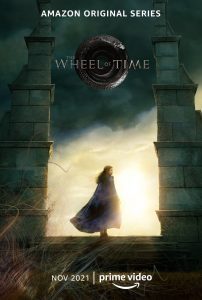 The Dark Along the Ways begins with what is possibly my favourite scene of the series so far. In one of the best fantasy action scenes shown on TV, a heavily pregnant Aiel rushes across a snowy landscape, fighting off a bunch of warriors with incredible skill. She uses her opponents’ weapons against them and wields a spear with unnerving ability and accuracy in one of the show’s goriest and best scenes yet.
The Dark Along the Ways begins with what is possibly my favourite scene of the series so far. In one of the best fantasy action scenes shown on TV, a heavily pregnant Aiel rushes across a snowy landscape, fighting off a bunch of warriors with incredible skill. She uses her opponents’ weapons against them and wields a spear with unnerving ability and accuracy in one of the show’s goriest and best scenes yet.
Finally, dropping to the ground, the red-haired Aiel gives birth to a baby with the support of a stricken warrior carrying a heron blade. The Dark Along the Ways is bookended with this magnificent scene and an ending where Rand discovers that he is in fact the Dragon Reborn. That’s one big reveal out of the way for the series. And what a way to do it.
The Dark Along the Ways has slower moments in between. Moiraine and Lan lead the group through the dark Ways as they argue over leaving Mat behind. The dark, creepy land grows more ominous as one of the guiding stones shows signs of being defiled. A trolloc attacks and is repelled with magic (by whom?) and the band must rush forwards as Loial leads them to a different exit than previously planned.
They escape the Ways but not before the Black Wind whispers into the minds of the group and digs deep to get at their darkest fears. Like Boromir leaving Lothlorien following the meeting with Galadriel, the group are broken and lost in their dark thoughts as they arrive in Fal Dara. The group bicker like children as their fears and doubts take over, worrying about the fact that they still do not know which of them is the Dragon Reborn and that the rest of them will die once they reach the Eye of the World. Needing comfort, Rand and Egwene spend the night together and so do Nynaeve and Lan, who reveals more about his history and the people whom he cares for the most.
In the morning, the group get together to make a decision on whether they should head off to the Eye of the World or not. Rand, finally realising who he is, doesn’t turn up and neither does Moiraine. The two of them leave the city before dawn and head towards the Blight, hoping to save the others from their inevitable deaths.
The Dark Along the Ways is a slow episode with more character development and comes across as an episode designed to set up the ending of what has been a mostly enjoyable series. It is great to see more of Lan who has been a standout character in the series and the fight in the snow is a sign of the potential the series has to become the epic fantasy the fans deserve to see. The pieces are all coming together and it will be fascinating to see how the show wraps up its first season. On the 20th anniversary of the Lord of the Rings trilogy hitting cinema screens, it is great to see shows like The Wheel of Time and The Witcher showing what fantasy is capable of on the small screen.
The post REVIEW: The Wheel of Time E7: The Dark Along the Ways appeared first on Grimdark Magazine.
REVIEW: The Witcher: Season 2 Episode 2: Kaer Morhen
Welcome to the recaps of The Witcher Season 2 for Grimdark Magazine. I’m Ryan, and I enjoyed the first season of this show a lot. I haven’t read the books so a lot of the plot points will be coming at me for the first time.
Kaer Morhen starts with Geralt and Ciri finally making their way to Kaer Morhen, the place where Witchers go to rest and recuperate over wintertime. The set design seems to have pulled a lot from the video games, which I found interesting. I don’t recall set design being taken from a video game before, but it works.
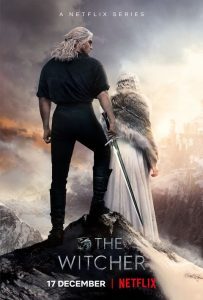 We see several Witchers already here, and they all have a strong bond of brotherhood. While it seems outwardly positive how well they know each other, there is an unfortunate undercurrent to this, one vocalized by Geralt as he discusses his childhood to Ciri. Kaer Morhen had been attacked, and Vesemir was the only older trainer to survive. The number of Witchers is running low, and there is no way for more to be created.
We see several Witchers already here, and they all have a strong bond of brotherhood. While it seems outwardly positive how well they know each other, there is an unfortunate undercurrent to this, one vocalized by Geralt as he discusses his childhood to Ciri. Kaer Morhen had been attacked, and Vesemir was the only older trainer to survive. The number of Witchers is running low, and there is no way for more to be created.
The monster of the week in this was far less interesting than last week’s. The monster design was again very well done, as the monster looked interesting in a very pulp, almost comic-book way. But the fight itself had been telegraphed early on. No, the real interest here was seeing how the witchers all relate to each other, and particularly how Vesemir and Geralt relate. This lets Geralt take on Vesemir’s role as trainer and mentor to Ciri.
Yennefer, meanwhile, has been captured along with Fringilla by elves. She tries using her wits as best she can to convince them that she’s more valuable alive and free. Since her capture after the Battle of Sodden, she’s been put into deuterium handcuffs, a special metal that prevents spellcasting. During the battle where she was captured by elves, she begged Fringilla to rescue her, saying she could save them if only she was freed on the handcuffs.
 The elves end up taking them on a journey that leads to powerful old beings who offer them great power and tempt them down various paths.
The elves end up taking them on a journey that leads to powerful old beings who offer them great power and tempt them down various paths.
All of this leads Yennefer to realize that it’s not the deuterium, but the fire magic she had used at the end of Season 1. She has burned out her own magical power.
The post REVIEW: The Witcher: Season 2 Episode 2: Kaer Morhen appeared first on Grimdark Magazine.
December 29, 2021
REVIEW: Demon by Matt Wesolowski
I received an uncorrected proof copy of Demon in exchange for an honest review. Thank you to Matt Wesolowski and Orenda Books.
 Demon is the sixth book in Wesolowski’s Six Stories series and in this entry, enigmatic journalist Scott King interviews six witnesses of a horrendous crime that occurred 26 years ago at the quaint village of Ussalthwaite. On his podcast, the crime that the interviewer is looking back at is the ferocious murder of a 12-year-old child with learning difficulties who was killed by 2 other children of the same age. The “demonic duo” were released in 2002 with anonymity and new identities. Present-day, a member of the public claims to have discovered the identity of one or both of the murderers and is bargaining to sell the information to the highest bidder. Opinions and interest in this famous case have become intense, and now Scott King is raking over the grave of this old crime. Will the majority of the public believe in the rehabilitation of the pair or that retribution for the heinous crime is deserved? What will King unearth during his exchanges with these 6 individuals? Is it of importance that Ussalthwaite (a fictional town in Yorkshire) has a history that is shrouded in mystery including witches and the supernatural? Also intriguing, what are King’s motives for talking about this case now?
Demon is the sixth book in Wesolowski’s Six Stories series and in this entry, enigmatic journalist Scott King interviews six witnesses of a horrendous crime that occurred 26 years ago at the quaint village of Ussalthwaite. On his podcast, the crime that the interviewer is looking back at is the ferocious murder of a 12-year-old child with learning difficulties who was killed by 2 other children of the same age. The “demonic duo” were released in 2002 with anonymity and new identities. Present-day, a member of the public claims to have discovered the identity of one or both of the murderers and is bargaining to sell the information to the highest bidder. Opinions and interest in this famous case have become intense, and now Scott King is raking over the grave of this old crime. Will the majority of the public believe in the rehabilitation of the pair or that retribution for the heinous crime is deserved? What will King unearth during his exchanges with these 6 individuals? Is it of importance that Ussalthwaite (a fictional town in Yorkshire) has a history that is shrouded in mystery including witches and the supernatural? Also intriguing, what are King’s motives for talking about this case now?
All in all, I found Demon to be a gripping, engaging, and thought-provoking horror/mystery tale that is presented in an intriguing and addictive way. It’s mostly written in the form of an interview with well-timed, informative, and realistic back-and-forths between interviewer and interviewees. The book has breaks that feature letters, e-mails, and social media updates which adds depth and consequence to unfolding events. My uncorrected proof copy was 225-pages long, with each episode being about a sixth of that length, making it perfect to read one chapter per evening and therefore devouring this short but packed novel within a week. Each episode adds layers and new angles to what we understand about the case so far. It’s interesting to discover each guest’s role in the story, and also what their motives are, and whether they have any demons themselves. Demon is dark, sometimes gruesome, occasionally featuring torturous happenings and Wesolowski himself warns readers that distress may be caused to some as there is fictional violence to children and animals.
I haven’t read any of the other Six Stories books prior to reading this one and can confirm that it works perfectly as a standalone. I am sure I would have had a heightened reading experience if I had read the previous series entries but even without the back story about Scott King or how this links into the overarching Six Stories world, I’m still rating this an extremely positive 8.5/10. At some moments, King does allude to his dark past and events that have happened to him before, and I wasn’t upset that I didn’t understand the references, in fact, it intrigued me to the extent where I’ll probably go back and work my way through the series.
Reading Demon was a captivating and rewarding experience especially as I’m sure I had my amateur sleuth hat on throughout my time reading, trying to put the pieces of the puzzle together myself before King or a guest reveal something of importance. The novel doesn’t wrap up neatly, leaving a lot to the reader’s interpretation. What influence, if any, was down to the supernatural is something I was thinking about throughout but I won’t mention how that sits at the conclusion. It isn’t disappointing that it doesn’t end neat and tidy but it means that you’ll probably be thinking about this story and the possibilities long after finishing it. I can’t get some of the characters and events out of my head. I was thoroughly impressed with Wesolowski’s format, writing, and the complexity of this dark tale.
Read Demon by Matt Wesolowski
The post REVIEW: Demon by Matt Wesolowski appeared first on Grimdark Magazine.
REVIEW: The Witcher: S2 E1: A Grain of Truth
Welcome to the recaps of The Witcher Season 2 for Grimdark Magazine. I’m Ryan, and I enjoyed the first season of this show a lot. I haven’t read the books so a lot of the plot points will be coming at me for the first time. That said, this episode, A Grain of Truth, is taken from the story of the same name in Sapkowski’s The Last Wish.
 Season 2 of The Witcher has dispensed with Season 1’s timeline shenanigans. It still maintains two story arcs, of Yennefer after the Battle of Sodden Hill, and Geralt of Rivia after he finally meets Ciri. Yennefer’s plotline in this episode felt like a bit of wheel-spinning until the end, so more on her in the next recap.
Season 2 of The Witcher has dispensed with Season 1’s timeline shenanigans. It still maintains two story arcs, of Yennefer after the Battle of Sodden Hill, and Geralt of Rivia after he finally meets Ciri. Yennefer’s plotline in this episode felt like a bit of wheel-spinning until the end, so more on her in the next recap.
Ciri and Geralt are still figuring each other out, and though she seems to view him as a protector, they haven’t quite developed a full familial bond yet. She’s still lonely and misses her family and Cintra. Geralt, meanwhile, believes that Yennefer died at Sodden, and while he keeps things close to his chest, he’s clearly mourning.
On their way to Kaer Morhen, they arrive at a small wintry town. Before they enter Geralt notices that not only are there no guards, there are no barking dogs. Luckily, Geralt knows someone who lives nearby, because Geralt always knows someone—it’s one of the features about him I like most. It makes sense that a wandering monster hunter would happen to befriend some of the people he helps, an attitude that doesn’t ignore the ‘Witchers are despised’ belief prevalent in the setting so much as underpin it. The world is a large place and people are not a monolith.
[image error]Geralt and Ciri’s story largely takes place at this old friend’s manor house, and this entire sequence is exceptional. His friend, Nivellen, has been cursed, but won’t talk about it. He seems outwardly gregarious and inwardly hiding something, and the actor, (Kristofer Huvju, Tormund from Game of Thrones) absolutely nails it despite the prosthetics. The sequence where he and Geralt play a drinking game based around throwing daggers at a painting of Nivellen’s father was a highlight of the episode. Each time either of them gets a dagger in, they can ask a question and get a truthful answer. But Nivellen is clearly playing Geralt as much as he’s playing their drinking game.
While he turns to have a few secrets, the most notable is that he has a Bruxa, a vampire, living at his manor.
Her introduction is creepy, and the creature design is exceptional, some of the best the series has done. Her motions are uncanny in the best way, giving a real sense that she is indeed something monstrous. But when she talks she quite clearly states that while she is a monster, she has done nothing that humans don’t do. That tension has always been at the heart of this series.
Check Out Our Reviews for Season 1
The post REVIEW: The Witcher: S2 E1: A Grain of Truth appeared first on Grimdark Magazine.
December 28, 2021
REVIEW: String Follow by Simon Jacobs
There is a quiet horror influencing the youth of Adena, Ohio. A mysterious force that doesn’t poison their young hearts but rather distorts their desires into something sinister. Simon Jacobs delivers an oddly curious and uncanny horror tale in String Follow.
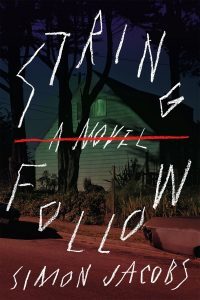 String Follow is narrated by this mysterious force. As readers, we are privy to its musing as it stalks various characters. Beth lives in the shadow of her abusive and psychotic brother, Greg. David turns to incel-like cults and fantasies when his love is unreturned from Sarah. Unbeknownst to him, Tyler has found refuge in David’s basement. We follow a web of these characters and more, all seemingly random and yet, their fates are all intertwined.
String Follow is narrated by this mysterious force. As readers, we are privy to its musing as it stalks various characters. Beth lives in the shadow of her abusive and psychotic brother, Greg. David turns to incel-like cults and fantasies when his love is unreturned from Sarah. Unbeknownst to him, Tyler has found refuge in David’s basement. We follow a web of these characters and more, all seemingly random and yet, their fates are all intertwined.
In String Follow, Simon Jacobs does a brilliant job of portraying the youthful lives of those in the Midwest. Often, his characters’ actions and thoughts linger between the mundane and the bizarre. He accentuates their whims and impulses. He portrays their erratic behaviors believably. String Follow is about observing seemingly disjointed actions from all its characters steadily become tangled with each other.
String Follow has a flair that is reminiscent of Donnie Darko and The Twilight Zone. Simon Jacobs’s prose is particularly notable. The way in which the author writes is spellbinding and invokes an atmosphere of dread. As enticing as it is unsettling, his prose is the highlight of this novel.
Simon Jacobs does not humor his readers with jump scares, but a slow unraveling of atrocities committed by his characters. While the mysterious force can be perceived as unworldly, the horrors set in String Follow are grounded in unfortunate reality. Woven between the scenes of teenage meanderings, we are exposed to parental neglect, shootings, abuse, and violence.
This gothic novel does suffer from having one too many characters. Some character arcs felt lacking in comparison to the rest. On a few occasions, the abundance of characters hindered the momentum of the story. Since we have the perspective of the mysterious force but are blinded to its intensions, it is easy to miss the importance of certain individuals. The best strategy is to let the mysterious force reveal and connect these characters for you. It does come together at the end.
String Follow is a dark and somber coming-of-age tale. It begs us to give credence to the dark parts of ourselves. Jealousy and anger are not fleeting sentiments. With a simple nudge, they can consume a person.
Read String Follow by Simon Jacobs
The post REVIEW: String Follow by Simon Jacobs appeared first on Grimdark Magazine.
December 27, 2021
REVIEW: Servant Mage by Kate Elliott
Kate Elliott packs an assortment of fully-realized story elements into her new novella, Servant Mage. The narrative focuses on the journey of Fellian, a low-level mage, interweaving significant themes of power, class, loss, and choice in a believable way. As Fellian reacts to the world around her, so does the reader; their paths paralleled as Elliott widens the scope of traditional fantasy tropes and alters predictable expectations.
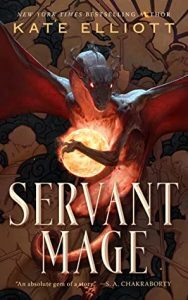 Servant Mage begins with the echoes of a revolution. Fellian finds herself an indentured servant to the Liberationist Government due to her ability as a Lamplighter: the ability to create and sustain light through the demonic presence bound to one’s bones. All Fellian wants to do is give those around her the ability to read and write, teaching them in secret while she cleans the upper class’s privies. However, when an opportunity arises for her freedom, Fellian is caught between the Liberationists and the Monarchists. She begins to question the world around her, starting with the truth about the foundation of her society. Fellian must decide between helping the Monarchists vie for their chance at regaining power through the birth of a recent royal child or her duty to what she has always known.
Servant Mage begins with the echoes of a revolution. Fellian finds herself an indentured servant to the Liberationist Government due to her ability as a Lamplighter: the ability to create and sustain light through the demonic presence bound to one’s bones. All Fellian wants to do is give those around her the ability to read and write, teaching them in secret while she cleans the upper class’s privies. However, when an opportunity arises for her freedom, Fellian is caught between the Liberationists and the Monarchists. She begins to question the world around her, starting with the truth about the foundation of her society. Fellian must decide between helping the Monarchists vie for their chance at regaining power through the birth of a recent royal child or her duty to what she has always known.
The novella oozes with political intrigue and thematic elements from its opening lines. Elliott immediately lays the groundwork for what Fellian’s world is like. Servant Mage is threaded with tension from a political standpoint, and like Fellian, you begin to wonder which side is better equipped for control as the issues of power are explored from all angles. Elliott also pays strong attention to the class system, blatantly displaying its dependencies on educational means (both practical and magical) to everyday necessities like bathing and eating.
Although not grimdark, Servant Mage explores the darker aspects of a society dueling for power, control, and the right to rule. Elliott peppers in realistically bleak moments as Fellian seeks out the answers to how far one would go to achieve their goals and whether the cost justifies the means. Every character decision is steeped in consequence whether short or long-term. The undercurrent of the importance of choice is demonstrated in several instances, both in regards to the plot and characters. However, perhaps the single greatest lesson Fellian must learn is also the one most relatable: “There’s more to the world than we are allowed to know” (164).
Thank you to Tordotcom for sending me an ARC of Servant Mage to review.
Read Servant Mage by Kate Elliott
The post REVIEW: Servant Mage by Kate Elliott appeared first on Grimdark Magazine.
December 26, 2021
REVIEW: Crimson Thaw #3
World of Darkness: Crimson Thaw #3 is the third and final installment of the Crimson Thaw spinoff and last comic book dealing with the protagonists of Vampire: The Masquerade: Winter’s Teeth, a ten-issue preceding miniseries. They are both set in White Wolf’s World of Darkness that was mega-popular in the Nineties and is only now making a return.
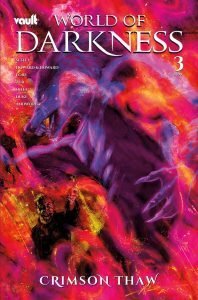 The premise is the vampires of Minneapolis and Saint Paul have accidentally defiled the holy grounds of a group of Garou (werewolves), erecting magical barriers that keep out werewolves. Despite this being just another acquisition to them, the local werewolves take it as a declaration of war. After killing one of Prince Cecily Bain’s close friends, the issue is further complicated by the arrival of Justicar Ian Carfax that has his own plans for the Garou.
The premise is the vampires of Minneapolis and Saint Paul have accidentally defiled the holy grounds of a group of Garou (werewolves), erecting magical barriers that keep out werewolves. Despite this being just another acquisition to them, the local werewolves take it as a declaration of war. After killing one of Prince Cecily Bain’s close friends, the issue is further complicated by the arrival of Justicar Ian Carfax that has his own plans for the Garou.
Ian Carfax is a Justicar of the Camarilla and thus one of the most powerful vampires alive. He has been feeding on werewolves to hold off the mysterious “Beckoning” but has greater ambitions than that. He believes by learning the secrets of Garou spirit magic that he’ll be able to devour the power of Mother Earth and make himself a god. You know, basic supervillain stuff.
Unfortunately, for Ian, Garou are not reasonable about their magic or holy places. This triggers Cecily Bain trying to decide how to bring peace to her land while also rebelling against the man who put her in charge of the Twin Cities (an unforgivable offense). I really liked the twists and turns here but would have appreciated an additional two issues to better explore the fallout from Mitch’s death as well as more character interaction between Cecily and her Anarch friends. Sadly, I feel like this will be the last time we deal with them.
I feel like the final confrontation between the werewolves, Ian Carfax, and Cecily was a bit on the rushed side, though. I don’t think a Justicar would ever allow himself too far from his Archons and support, so I didn’t quite buy the ending. I also was curious why he was still in the Twin Cities when his business concluded at the end of Winter’s Teeth.
Storyline-wise, I feel like this is a pretty good endpoint for Cecily Bain as it provides a sense of what she’s going to be like for the next few decades and how she’s going to evolve as a Prince. Unfortunately, the Anarchs don’t get a much time as they deserve and there’s no room to really discuss Colleen’s feelings about the death of her husband. Still, I feel like we could have had worse follow-ups.
The art is excellent, and I really like the way everyone is depicted. Cecily is quite fetching in her less Gothic Punk ensemble and more fashionista look. It goes to show that clothes make the Prince. I do think the book didn’t have much in the way of gaming material in the back and that’s a shame, especially since the first issue gave some hints about Werewolf: The Apocalypse 5th Edition. On the other hand, they gave a nice short story this time.
Read Crimson Thaw #3
The post REVIEW: Crimson Thaw #3 appeared first on Grimdark Magazine.
December 25, 2021
Best dark SFF books of 2021
Well, 2021 was pretty much another bag of sweaty dicks of a year with lockdowns, deaths, separation, isolation, bloody zoom meetings, and dead arms. However, the publishing industry great and small, despite paper shortages, shipping madness, and an industry full of people trying to juggle home schooling and the mental pressure of delivering books despite *waves arms* everything have delivered some epic adventures.
The GdM reviewer team gives you our favourite books of 2021.
Empire of the Vampire by Jay KristoffPicked by Fiona Denton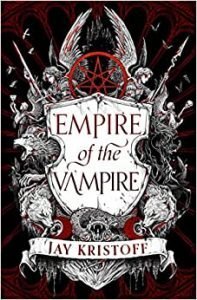 Empire of the Vampire starts with a simple premise, what happens when the sun stops shining? The world is plunged into near constant darkness, crops fail, and creatures of myth turn out to be real and no longer have the constraints of daylight to hold them back. The vampires in Kristoff’s gothic grindark masterpiece are terrifying predators with preternatural strength and speed. The religious order of the Silversaints make it their lives’ work to keep humanity safe and the novel opens with our morally ambivalent protagonist, Gabriel de Lioncourt, the last Silversaint, recounting the story of his life. The dual narratives following the story of Gabriel’s life from childhood and the catastrophic events of adult hood slowly converging. Empire of the Vampire is a gorgeous book, black edged pages, an embossed cover, and at just shy of a thousand pages it is a very worthwhile long read. If you can imagine the love child of Interview with the Vampire and The Name of the Wind, you’re close to Empire of the Vampire. Gabriel’s coarse dark humour appealed to me and the split narratives were equally as engrossing. Some parts of this novel made me laugh, other parts made me cry. It’s been my favourite read of 2021 and I’m so excited for the second installment.
Empire of the Vampire starts with a simple premise, what happens when the sun stops shining? The world is plunged into near constant darkness, crops fail, and creatures of myth turn out to be real and no longer have the constraints of daylight to hold them back. The vampires in Kristoff’s gothic grindark masterpiece are terrifying predators with preternatural strength and speed. The religious order of the Silversaints make it their lives’ work to keep humanity safe and the novel opens with our morally ambivalent protagonist, Gabriel de Lioncourt, the last Silversaint, recounting the story of his life. The dual narratives following the story of Gabriel’s life from childhood and the catastrophic events of adult hood slowly converging. Empire of the Vampire is a gorgeous book, black edged pages, an embossed cover, and at just shy of a thousand pages it is a very worthwhile long read. If you can imagine the love child of Interview with the Vampire and The Name of the Wind, you’re close to Empire of the Vampire. Gabriel’s coarse dark humour appealed to me and the split narratives were equally as engrossing. Some parts of this novel made me laugh, other parts made me cry. It’s been my favourite read of 2021 and I’m so excited for the second installment.
Read our review of this book, here.
About the book: For nearly three decades, vampires have waged war against humanity; building their eternal empire even as they tear down our own. Now, only a few tiny sparks of light endure in a sea of darkness.
Gabriel de León, half man, half monster and last remaining silversaint – a sworn brother of the holy Silver Order dedicated to defending the realm from the creatures of the night – is all that stands between the world and its end.
Now imprisoned by the very monsters he vowed to destroy, the last silversaint is forced to tell his story. A story of legendary battles and forbidden love, of faith lost and friendships won, of the Wars of the Blood and the Forever King and the quest for humanity’s last remaining hope:
The Holy Grail.
Read Empire of the Vampire by Jay Kristoff
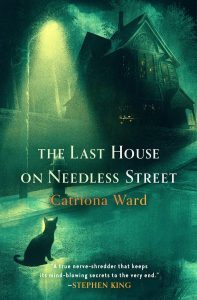 This book knocked my socks off. For the first time in many years, I truly had no idea what was about to happen next as the layers were pulled back, with each revelation further misdirecting my assumptions. It’s safe to say I’ve never read anything like The Last House On Needless Street. Ward has truly achieved something special with this novel and I can’t wait to see what she has in store in the future.
This book knocked my socks off. For the first time in many years, I truly had no idea what was about to happen next as the layers were pulled back, with each revelation further misdirecting my assumptions. It’s safe to say I’ve never read anything like The Last House On Needless Street. Ward has truly achieved something special with this novel and I can’t wait to see what she has in store in the future.
Check out Eugene’s review here.
About the book: This is the story of a murderer. A stolen child. Revenge. This is the story of Ted, who lives with his daughter, Lauren, and his cat, Olivia, in an ordinary house at the end of an ordinary street.
All these things are true. And yet some of them are lies.
You think you know what’s inside the last house on Needless Street. You think you’ve come across this story before. In the dark forest at the end of Needless Street, something lies buried. But it’s not what you think….
Read The Last House On Needless Street by Catriona Ward
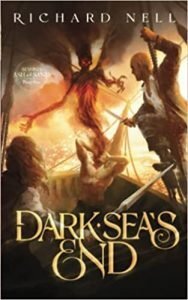 This book opened a new chapter in the world of Ash and Sand bringing back someone I think is one of the most compelling and iconic dark fantasy protagonists in recent years – Ruka. This time you see him through the eyes of others who see him as a living legend. I could barely put this one down and hope to see more set in this world.
This book opened a new chapter in the world of Ash and Sand bringing back someone I think is one of the most compelling and iconic dark fantasy protagonists in recent years – Ruka. This time you see him through the eyes of others who see him as a living legend. I could barely put this one down and hope to see more set in this world.
About the book: Feared pirate and scoundrel ‘Lucky’ Chang has a dirty secret: he loves his crew, and would die to protect them. As he’s dragged from prison to face the dark sea and a dangerous new world, he just might have to.
Zaya, warrior and skald from the land of ash, knows she has a destiny. Having left her homeland with only a knife and a dream of adventure, she finds herself captured by pirates. To discover her fate, and become a hero from the book of legends, she must first survive the sea.
With a monstrous pilot as guide, and an ex-assassin as captain, Chang, Zaya, and the crew of the mighty Prince sail into uncharted waters. There they may find new lands and wealth, as well as glory beyond their dreams, or nothing but their doom.
Read Dark Sea’s End by Richard Nell
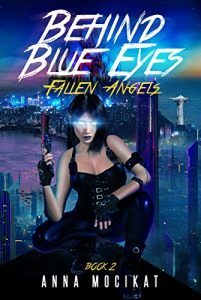 The exciting sequel to Behind Blue Eyes. A serial killer is targeting the hyper-powerful assassins of the Olympias Corporation and taking them down with no effort. I absolutely loved its action, twists, turns, and allusions to classic literary dystopias.
The exciting sequel to Behind Blue Eyes. A serial killer is targeting the hyper-powerful assassins of the Olympias Corporation and taking them down with no effort. I absolutely loved its action, twists, turns, and allusions to classic literary dystopias.
Read Charles’ review, here.
About the book: Olympias City is shaken by a series of unspeakably brutal murders. No one is allowed to know the shocking truth about who the victims are: Guardian Angels.
Someone is hunting the almost invincible cyborgs with the neon-blue eyes. Someone who knows their secrets and who uses a formerly unknown technology.
Promoted to Archangel, Nephilim is in charge of the investigation. It leads her into the underbelly of Olympias’ most notorious district, Oldtown, and also into the Inner Circle, where the elites reside.
Struggling with memory loss, Nephilim barely survives an attempt on her life.
It seems that the Guardian Angels have some very powerful enemies. If this wasn’t dangerous enough, the two other corporate global players, Rosprom and TogbuaXiang, scheme in the shadows to not only bring down the Angels but the entire city of Olympias.
Everything changes when Nephilim accompanies Metatron on a trip to Olympias City III, formerly Rio de Janeiro. There she discovers that nothing is what it seems and that Metatron is much more cunning and dangerous than anyone suspects.
Things get even more complicated when old friends from Nephilim’s past appear. Nephilim will have to decide on what side she wants to stand …
Read Behind Blue Eyes: Fallen Angels by Anna Mocikat
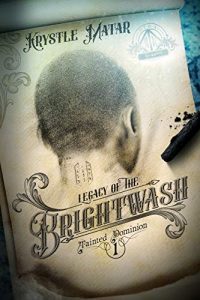 Krystle Matar’s debut, Legacy of the Brightwash, introduces readers to a well-fleshed out, grim, and bleak world. Her prose interweaves realistic human emotion into her character motivations. Pairing her mastery of tension with a slow build, Matar balances the brutality of the story with quiet moments of hope and love.
Krystle Matar’s debut, Legacy of the Brightwash, introduces readers to a well-fleshed out, grim, and bleak world. Her prose interweaves realistic human emotion into her character motivations. Pairing her mastery of tension with a slow build, Matar balances the brutality of the story with quiet moments of hope and love.
Read our review, here.
About the book: Follow the law and you’ll stay safe. But what if the law is wrong?Tashué’s faith in the law is beginning to crack. Three years ago, he stood by when the Authority condemned Jason to the brutality of the Rift for non-compliance. When Tashué’s son refused to register as tainted, the laws had to be upheld. He’d never doubted his job as a Regulation Officer before, but three years of watching your son wither away can break down even the strongest convictions.
Then a dead girl washed up on the bank of the Brightwash, tattooed and mutilated. Where had she come from? Who would tattoo a child? Was it the same person who killed her? Why was he the only one who cared?
Will Tashué be able to stand against everything he thought he believed in to get the answers he’s looking for?
Read Legacy of the Brightwash by Krystle Matar
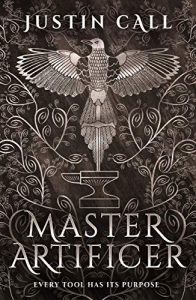 The first book of the series was outstanding, however the second novel really allowed Call to dive into the darker parts of the characters psyches. By the end you have no idea who is good or bad. It’s outstanding.
The first book of the series was outstanding, however the second novel really allowed Call to dive into the darker parts of the characters psyches. By the end you have no idea who is good or bad. It’s outstanding.
Read our review, here.
About the book: Annev has avoided one fate. But a darker path may still claim him . . .
After surviving the destruction of Chaenbalu, new mysteries and greater threats await Annev and his friends in the capital city of Luqura. As they navigate the city’s perilous streets, Annev searches for a way to control his nascent magic and remove the cursed artifact now fused to his body.
But what might removing it cost him?
As Annev grapples with his magic, Fyn joins forces with old enemies and new allies, waging a secret war against Luqura’s corrupt guilds in the hopes of forging his own criminal empire. Deep in the Brakewood, Myjun is learning new skills of her own as apprentice to Oyru, the shadow assassin who attacked the village of Chaenbalu – but the power of revenge comes at a daunting price. And back in Chaenbalu itself, left for dead in the Academy’s ruins, Kenton seeks salvation in the only place he can: the power hoarded in the Vault of Damnation . . .
Read Master Artificer by Justin Travis Call
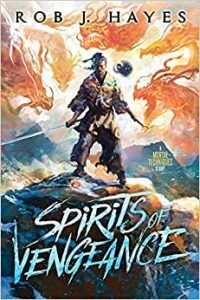 Amazing adventure, incredible action, great characters, but the thing Hayes does like the very best of traditionally published fantasy novelists is develop not only the characters but their relationships to one another, which makes this great read emotionally gripping like the best fiction of any genre.
Amazing adventure, incredible action, great characters, but the thing Hayes does like the very best of traditionally published fantasy novelists is develop not only the characters but their relationships to one another, which makes this great read emotionally gripping like the best fiction of any genre.
About the book: He’ll die as many times as it takes.
The Ipian Empire was once a land that welcomed dragons and spirits alike, but a century of war and bloodshed saw them all but vanish. Now, the lost things are returning and the Onryo have gathered. Five legendary spirits with mysterious powers, bent on freeing an ancient evil that would wreak havoc on humanity.
Haruto swore his soul to the God of Death for the chance to hunt down the vengeful ghost of his wife. Now an onmyoji, he’s tasked by the Imperial Throne to hunt down monsters and malicious spirits. But he knows not all spirits are evil and not all deserve the peace of the sword.
Kira is a student at Heiwa, an academy for children with dangerous techniques. But she has a secret, she’s not like the other students. When the school is attacked, she flees with one of the tutors, determined to hide both from those who would kill her, and those who would use her.
As a plague of spirits sweeps across the land, the Onryo leave a bloody trail for Haruto to follow. But who’s hunting who?
Read Spirits of Vengeance by Rob Hayes
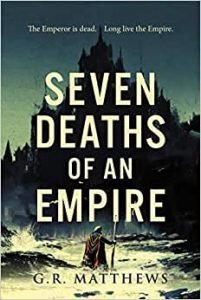 The Emperor is dead. Long live the Empire.
The Emperor is dead. Long live the Empire.
General Bordan has a lifetime of duty and sacrifice behind him in the service of the Empire. But with rebellion brewing in the countryside, and assassins, thieves and politicians vying for power in the city, it is all Bordan can do to protect the heir to the throne.
The perfect blend of classical fiction and grimdark. Can’t wait for the sequel!
Check out our review, here.
About the book: When the Emperor dies on campaign, destinies clash. Magician Kyron must escort the Emperor’s body back to the Capital through enemy territory; and General Bordan, veteran of many wars, must fight in the political arena for the security of the throne – and the Empire.
Read Seven Deaths of an Empire by G. R. Matthews
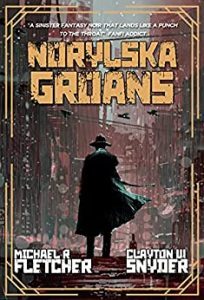 Grimdark steampunk Russian influenced fantasy set within an industrial city in Russian flavored fantasy world with mob families competing over magical memory stones…
Grimdark steampunk Russian influenced fantasy set within an industrial city in Russian flavored fantasy world with mob families competing over magical memory stones…
About the book: Norylska Groans…
with the weight of her crimes. In a city where winter reigns amid the fires of industry and war, soot and snow conspire to conceal centuries of death and deception.
Norylska Groans…
and the weight of a leaden sky threatens to crush her people. Katyusha Leonova, desperate to restore her family name, takes a job with Norylska’s brutal police force. To support his family, Genndy Antonov finds bloody work with a local crime syndicate.
Norylska Groans…
with the weight of her dead. As bodies fall, the two discover a foul truth hidden beneath layers of deception and violence: Come the thaw, what was buried will be revealed.
Read Norylska Groans by Michael R. Fletcher and Clayton W. Snyder
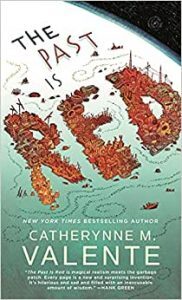 A post-apocalyptic slice of life novel about people living on the remains of what we left behind when we destroyed our planet, with a compelling protagonist who loves her world even as she hates what we did to it. The Past is Red is furious and delightful, bursting with life and voice and setting.
A post-apocalyptic slice of life novel about people living on the remains of what we left behind when we destroyed our planet, with a compelling protagonist who loves her world even as she hates what we did to it. The Past is Red is furious and delightful, bursting with life and voice and setting.
Read our review, here.
About the book: Catherynne M. Valente, the bestselling and award-winning creator of Space Opera and The Girl Who Circumnavigated Fairyland returns with The Past Is Red, the enchanting, dark, funny, angry story of a girl who made two terrible mistakes: she told the truth and she dared to love the world.
The future is blue. Endless blue…except for a few small places that float across the hot, drowned world left behind by long-gone fossil fuel-guzzlers. One of those patches is a magical place called Garbagetown.
Tetley Abednego is the most beloved girl in Garbagetown, but she’s the only one who knows it. She’s the only one who knows a lot of things: that Garbagetown is the most wonderful place in the world, that it’s full of hope, that you can love someone and 66% hate them all at the same time.
But Earth is a terrible mess, hope is a fragile thing, and a lot of people are very angry with her. Then Tetley discovers a new friend, a terrible secret, and more to her world than she ever expected.
Read The Past is Red by Catherynne Valente
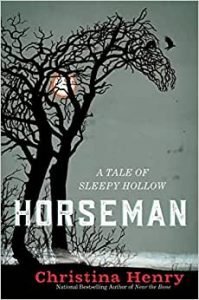 A thrilling tale which takes a well loved classic and “makes it new.” This is an evocative, rich piece which I particularly enjoyed thanks to the relevance and crisp, fresh voices given to the original characters as their lives and dynamics are reworked. Dark and oozing with menace, I shall certainly look for the next offering from this excellent writer.
A thrilling tale which takes a well loved classic and “makes it new.” This is an evocative, rich piece which I particularly enjoyed thanks to the relevance and crisp, fresh voices given to the original characters as their lives and dynamics are reworked. Dark and oozing with menace, I shall certainly look for the next offering from this excellent writer.
Read our review, here.
About the book: Everyone in Sleepy Hollow knows about the Horseman, but no one really believes in him. Not even Ben Van Brunt’s grandfather, Brom Bones, who was there when it was said the Horseman chased the upstart Crane out of town. Brom says that’s just legend, the village gossips talking.
More than thirty years after those storied events, the village is a quiet place. Fourteen-year-old Ben loves to play Sleepy Hollow boys, reenacting the events Brom once lived through. But then Ben and a friend stumble across the headless body of a child in the woods near the village, and the discovery makes Ben question everything the adults in Sleepy Hollow have ever said. Could the Horseman be real after all? Or does something even more sinister stalk the woods?
Read Horseman: A Tale of Sleepy Hollow by Cristina Henry
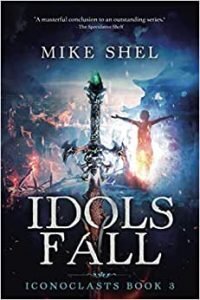
Note: Spoilers for Iconoclasts 1 and 2 ahead!
The epic conclusion to the horror/fantasy Iconoclasts series, Idols Fall follows adventurer Agnes Manteo as she takes up her father’s sentient blade and quests to slay a pantheon of cruel pretender gods. Meanwhile, Countess Ilanda Pavidale struggles to hold the kingdom of Hanifax together with the recent passing of its twisted immortal monarch, a court full of treacherous nobles, and barbarian horde on its borders. Authored by a psychotherapist/tabletop RPG writer, this series is the perfect blend of narrative dread, realistic trauma, and dungeon delving. Idols Fall is everything I hoped for and more in a conclusion to one of my favorite series with a masterfully woven plot and the single most brutal dungeon since Gygax’s Tomb of Horrors.
About this book: “AT LONG LAST, EVEN GODS WILL KNOW REGRET…”Agnes Manteo now bears her father’s sentient Djao sword, along with a terrible revelation—the gods are charlatans, ancient sorcerers who draw their strength from the suffering of humanity. She and her Syraeic companions have but a single duty: to track down those pretenders and end their reign of cruelty and lies. To that end, the magical blade—mighty, single-minded Szaa’da’shaela—won’t allow the slightest waver of their commitment.But the empire is a bubbling cauldron of turmoil with the sudden passing of its undying queen. Nobles clash and threaten civil war, murderous barbarians mass on the frontier in preparation for a bloody invasion, and all feel the aching void left by the clergy, whose temples were consumed by a great fire. How can the empire survive should Agnes succeed in tearing away its very foundations? And if she fails? What might sorcerers with nearly godlike powers do to exact their revenge?
Read Idols Fall by Mike Shel
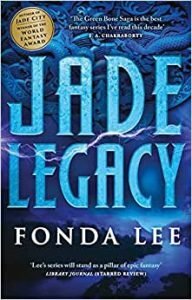 I have spent the last month residing in Lee’s spectacularly detailed and wonderfully crafted fantasy world. I’m certain that re-reading Jade City and Jade War prior to starting the mammoth-sized yet never dull Jade Legacy heightened my enjoyment of this entry greatly. In Jade Legacy, Lee has perfectly honed her fantasy and gangster thriller experience with more drama, bloodshed, showdowns, political intrigue, and higher costs.
I have spent the last month residing in Lee’s spectacularly detailed and wonderfully crafted fantasy world. I’m certain that re-reading Jade City and Jade War prior to starting the mammoth-sized yet never dull Jade Legacy heightened my enjoyment of this entry greatly. In Jade Legacy, Lee has perfectly honed her fantasy and gangster thriller experience with more drama, bloodshed, showdowns, political intrigue, and higher costs.
Lee is a fantastic writer and The Green Bone Saga has cemented itself in the top five series that I will recommend when people ask me for the best that I think the fantasy scene has to offer.
Read our review, here.
About the book: The Kaul siblings battle their rival clans for honour and control over an East Asia-inspired fantasy metropolis in Jade Legacy, the page-turning conclusion to the Green Bone Saga.
Read Jade Legacy by Fonda Lee
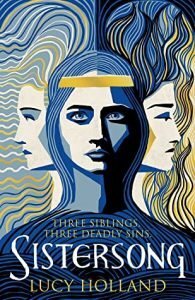
I chose this for our first roundup in the middle of the year and my love for it still runs strong. Sistersong is one of those special books that doesn’t come along all too often, and I adore it. Retelling the English folk ballad “The Twa Sisters”, it is both rooted in folklore and mythology, but also in medieval history and culture. The book combines my passions for diverse and queer stories and all things medieval, and introduces the reader to a wonderful cast of characters. I am particularly taken by Lucy Holland’s take on Merlin – without spoiling anything more – and loved Keyne most out of the siblings. At once haunting and lyrical, Sistersong is nevertheless dark and macabre (just go and check out the bone harp from the story that Lucy crafted with artist Becky Pepperdine).Read The Wisdom of Crowds by Joe Abercrombie.
About the book: My sister’s heart broke on the river—and the river took it and bore it away.
In the ancient kingdom of Dumnonia, there is old magic to be found in the whisper of the wind, the roots of the trees, and the curl of the grass. King Cador knew this once, but now the land has turned from him, calling instead to his three children. Riva can cure others, but can’t seem to heal her own deep scars. Keyne battles to be accepted for who he truly is—the king’s son. And Sinne dreams of seeing the world, of finding adventure.
All three fear a life of confinement within the walls of the hold, their people’s last bastion of strength against the invading Saxons. However, change comes on the day ash falls from the sky. It brings with it Myrdhin, meddler and magician. And Tristan, a warrior whose secrets will tear them apart.
Riva, Keyne and Sinne—three siblings entangled in a web of treachery and heartbreak, who must fight to forge their own paths.
Their story will shape the destiny of Britain.
Read Sistersong by Lucy Holland
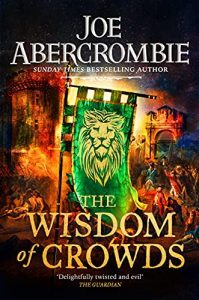 Having absolutely loved A Little Hatred and The Trouble with Peace, my expectations for The Wisdom of Crowds by Joe Abercrombie were absolutely sky high. With this gritty and fun book full of civil unrest, backstabbing, butchery, and even a little bit of love, Joe Abercrombie did not disappoint.
Having absolutely loved A Little Hatred and The Trouble with Peace, my expectations for The Wisdom of Crowds by Joe Abercrombie were absolutely sky high. With this gritty and fun book full of civil unrest, backstabbing, butchery, and even a little bit of love, Joe Abercrombie did not disappoint.
Read our review, here.
About the book: Some say that to change the world you must first burn it down. Now that belief will be tested in the crucible of revolution: the Breakers and Burners have seized the levers of power, the smoke of riots has replaced the smog of industry, and all must submit to the wisdom of crowds.
With nothing left to lose, Citizen Brock is determined to become a new hero for the new age, while Citizeness Savine must turn her talents from profit to survival before she can claw her way to redemption. Orso will find that when the world is turned upside down, no one is lower than a monarch. And in the bloody North, Rikke and her fragile Protectorate are running out of allies . . . while Black Calder gathers his forces and plots his vengeance.
The banks have fallen, the sun of the Union has been torn down, and in the darkness behind the scenes, the threads of the Weaver’s ruthless plan are slowly being drawn together . . .
Read The Wisdom of Crowds by Joe Abercrombie
Then check out our previous best of lists for:
2020201920182017The post Best dark SFF books of 2021 appeared first on Grimdark Magazine.
December 24, 2021
REVIEW: Crimson Thaw #2
World of Darkness: Crimson Thaw #2 is the second installment of the sequel to Vampire: The Masquerade: Winter’s Teeth. Unlike the first ten issues of the comic, it follows vampires and werewolves. Both of comic book series are in White Wolf’s World of Darkness, though, and specifically the Twin Cities of Minneapolis and Saint Paul. Crimson Thaw is set directly after the events of Winter’s Teeth, though, and not something you want to read on its own.
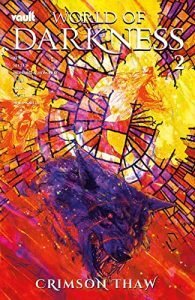 Cecily Bain is no longer the central character but part of an ensemble that consists of herself, the Anarchs, Calder Wendt, and a group of werewolves that believe the former to be pure evil. Which, given they’re vampires, is not an entirely unreasonable assumption. The previous book ended with the seeming death of Mitch Pendergrass and a declaration of war by the
Cecily Bain is no longer the central character but part of an ensemble that consists of herself, the Anarchs, Calder Wendt, and a group of werewolves that believe the former to be pure evil. Which, given they’re vampires, is not an entirely unreasonable assumption. The previous book ended with the seeming death of Mitch Pendergrass and a declaration of war by the
I particularly liked this comic because it has a kind of black humor element to it that provides a lot of information regarding the Garou (werewolves). The Garou were depicted as hyper-competant and ruthless in the previous book but now we get to find out just how utterly they’ve misread the situation. The story is actually a comedy of errors based around the fact the two races have almost nothing in common or no point of reference.
The vampires are primarily motivated by self-interest and a very materialist existence where only their needs matter. They are spiritually dead and what little religion they do possess is usually based around a corruption of Judeao-Christian mythology with Caine as their Dark Father. Werewolves are very spiritual, suicidally self-sacrificing, and worship the Earth Mother Gaia that they know to be literally true.
I won’t spoil the plot of the book but, essentially, one of the vampires in Saint Minneapolis buys a business for his girlfriend/vessel and puts up some magical protections on it. The business is on Garou land, and they take this as a masterful power move to show their dominance over the region. What is a completely unrelated act by a single vampire becomes part of a vast conspiracy because the idea the vampires aren’t some hostile force always plotting against them doesn’t fit into their worldview.
It’s doubly funny because the vampires, for once, aren’t up to any evil and have no interest in starting a conflict with the Garou. Because vampires don’t become involved in conflicts for evil’s sake. They do it because it benefits them and starting a war for no reason isn’t their style. The Garou believe everything is a conflict between good vs. evil, though, so the vampires don’t need a motive in their view.
The art is very good in these books and manages to be a lot more grounded than typical comic book action scenes. The expressions on everyone and designs are well done, fully bringing out the urban fantasy/horror mixture that characterizes the series. Sadly, the comic feels like its been truncated from a six issue story to a three issue story and that seriously is hurting its pacing.
Read Crimson Thaw #2
The post REVIEW: Crimson Thaw #2 appeared first on Grimdark Magazine.
December 23, 2021
REVIEW: The Matrix Resurrections
The Matrix was never a movie that needed a sequel and the Wachowski sisters originally wanted to do a prequel that eventually became The Animatrix “Second Renaissance” shorts. Instead, we got the controversial Matrix Reloaded and Matrix Revolutions. I personally loved the movies more for their world-building than their actual content. I was very excited but somewhat iffy about a fourth movie in the franchise since I wasn’t sure where the movie could possibly go.
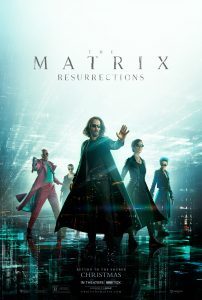 Hilariously, the first thirty minutes of The Matrix Resurrections is pretty much an extended commentary on how the Matrix trilogy stands alone and doesn’t need a sequel. There’s literally a scene where Thomas Anderson (Keanu Reeves), now trapped in the mundane life of a video game designer (Jonathan Groff), meets with his business partner who informs him that they’re making a fourth installment with or without him.
Hilariously, the first thirty minutes of The Matrix Resurrections is pretty much an extended commentary on how the Matrix trilogy stands alone and doesn’t need a sequel. There’s literally a scene where Thomas Anderson (Keanu Reeves), now trapped in the mundane life of a video game designer (Jonathan Groff), meets with his business partner who informs him that they’re making a fourth installment with or without him.
Thomas is thus forced into dealing with a much younger crew of people who loved The Matrix (here a popular series of video games) in junior high and proceed to lecture him on what made the series work. They talk about trans allegory, crypto-fascism, bullet-time, and armchair philosophy while Thomas just stares blankly forward. This isn’t so much subtext as clearly text of Lana Wachowski’s feelings on being paid gobs of money to return to a project they feel they’ve done all they can with. It’s hilarious, almost like Galaxy Quest really, but doesn’t bode well for the rest of the movie.
Subtextually, the movie is about retelling and restructuring stories in the same way Scream 2 was about sequels. The Matrix meant a lot of things to a lot of people in RL, and Thomas Anderson finds himself surrounded by the descendants of those he freed who want to pull him out of the Matrix again. Bug (Jessica Henwick) and Morpheus II (Yahya Abdul-Mateen II) are actors trying to fill big shoes but give a game performance.
The real stars are Keanu Reeves and Carrie Anne Moss, though, and why we’re here in the first place. The lack of Lawrence Fishburne and Hugo Weaving is felt considerably, though. Putting Jade Pinkett Smith in old age makeup also detracted from her own efforts. Priyanka Chopra Jonas made a surprising appearance as Sati (the now-adult little girl program from Revolutions) and while distracting, did a decent job. Note, I keep using somewhat guarded descriptions. No one is terrible but no one is really standing out except for our returning heroes.
Indeed, the biggest problem of the movie is the fact it plays it safe and feels like a tamer watered down version of the Matrix. None of the action scenes feel like they have any real weight to them and none of the characters feel like they are in any real danger. The original The Matrix killed the entirety of the Nebekenezer‘s crew to let you know how serious the bad guys were. Here, the “Bots” are unable to do any damage whatsoever. I was surprised Zion was destroyed (replaced by Io) because the new villains seemed so lacking in menace.
I got some serious Star Wars sequel trilogy vibes from the setting as well, which I wouldn’t put past Lana having done deliberately. The First Order Suits rise to power and overthrows the New Republic Machine-Human Alliance after blowing up Hosnian Prime Zion to restore the old status quo. Perhaps the worst part of it is that Neil Patrick Harris’ Analyst lacks even General Hux’s menace and comes across more like his Barney character griefing noobs in online multiplayer than the master of a vast electric fascist empire.
The movie is not bad, certainly, but the action feels tepid and danger-less while no one has much meat to their performances. It feels less offensive than The Last Jedi but it also doesn’t take the sort of risks that actually elevated that material to have a decent commentary on sequels as well as fan expectation. Really, the weirdest thing I can say for the movie is I was most interested in the mundane lives of Thomas Anderson and “Tiffany.” Why make Neo rich and famous rather than just miserable all the time? Were Tiffany’s kids computer programs or reprogrammed children? Are they children made from her DNA in the real world? Was her husband an Agent? I would have preferred that movie and I love Jessica Henwick.
In conclusion, I am going to give this movie a 6.5 out of 10 or maybe a 7 because it revives a franchise that didn’t need reviving as well as has some decent things to say. I think I might have actually preferred they do it full Galaxy Quest with deranged Matrix fans kidnapping Thomas Anderson for comedy for the first hour. Either that or lean hard into the R-rated action, cursing, anarchist sentiment, and scariness of the machines that made the originals so good. On the other hand, unlike a few other reboots, this is neither a shameless cash crab nor something that completely ruins the franchise. It’s just kind of there and mostly amusing.
The post REVIEW: The Matrix Resurrections appeared first on Grimdark Magazine.



